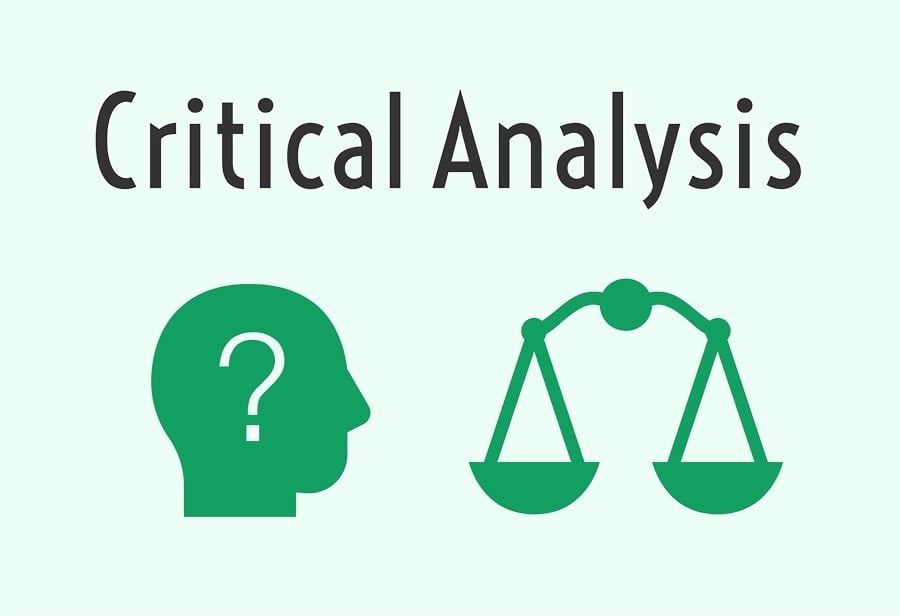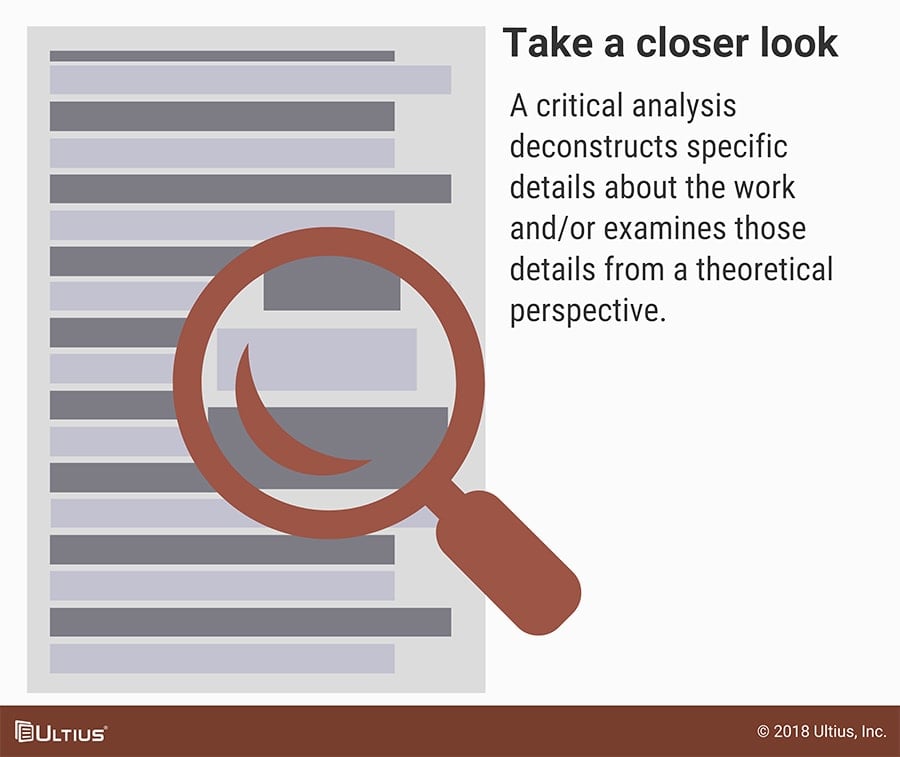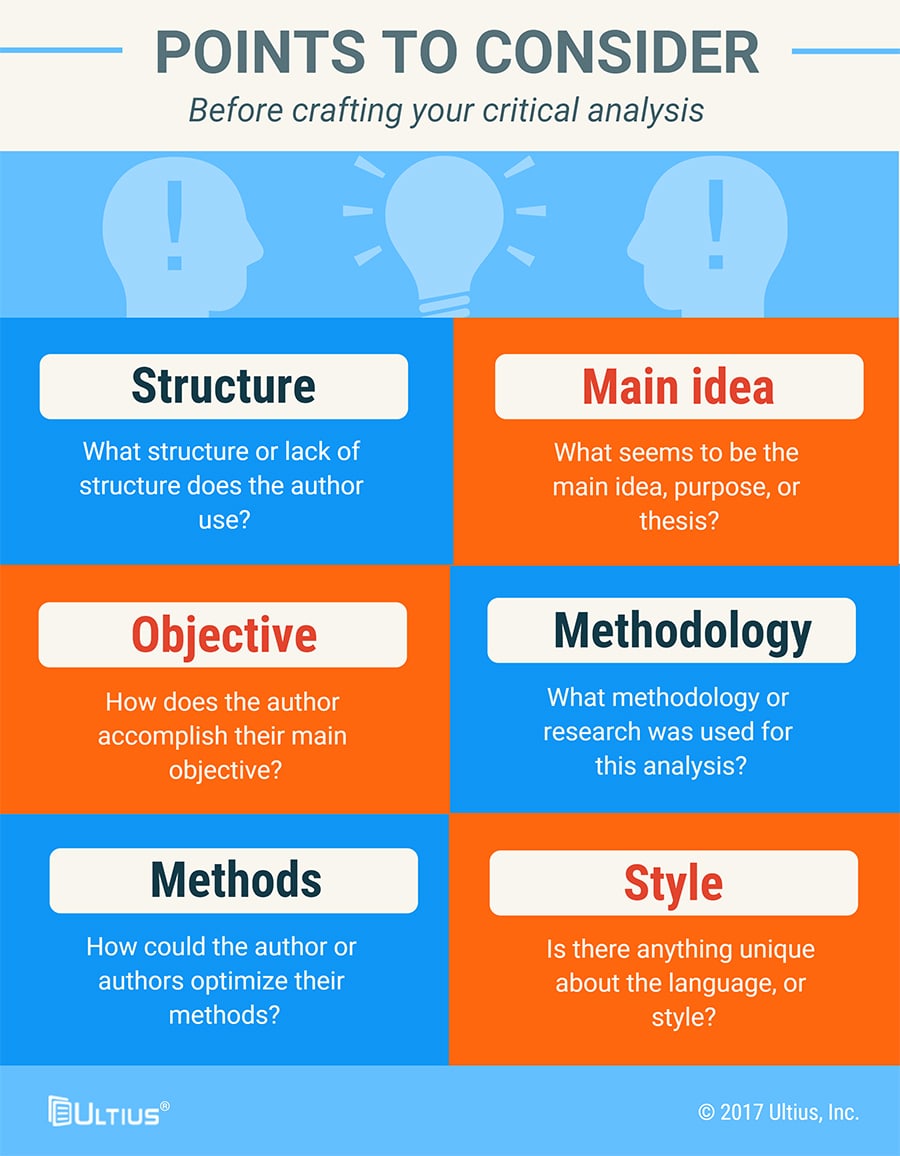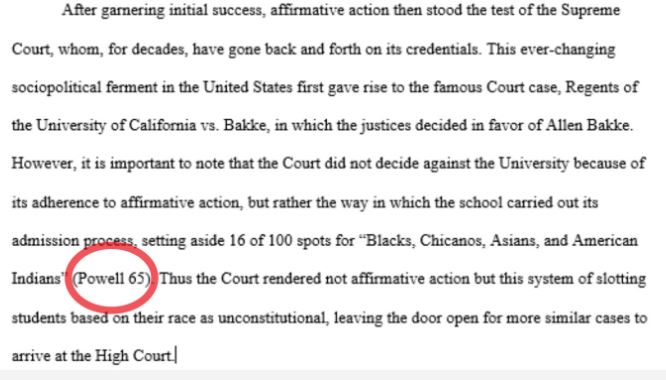Buy a critical analysis that increases your reader's understanding
The writers at Ultius can produce a critical analysis that breaks down significant aspects of the work being analyzed
Critical analyses require specific organization and a unique tone. Ultius works with professional writers who excel at creating critical analyses. A critical analysis is like a summary, but a summary is merely a synopsis of main points; while a critical analysis draws on the opinion of the writer and synthesizes new insights.
Your critical analysis will focus on the topic of your choice, such as a book or piece of literature, electronic media, or work of art.
-
Work with your writer to get every detail of your critical analysis perfect
Creating a stunning project is aided by collaboration between you and your writer. It is a team effort. You have access to our in-house support 24/7.
-
A critical analysis can cover films, games, books, articles, and more!
Critical analyses can cover a wide range of subject matter. We work with expert writers who not only excel at publication reviews, but theoretical evaluations, electronic media, and works of art.
-
Your critical analysis will be plagiarism free
Writers only use peer-reviewed material and databases to create custom critical analyses. They follow rules laid out in MLA, APA, CMS, and Turabian styles. Editors review for plagiarism to make sure nothing is missed.
-
Your critical analysis, done your way
Choose any topic that can be thoughtfully analyzed, and your writer will create a stunning document. Subjects can be anything from a literary work, a film, or almost any other type of creative art
Most critical analyses use MLA citation style. Writers use this guide to cite sources for your art analysis, literature review, theoretical evaluations, and more. This includes created a works cited page, ensuring all sources and quotes from peer-reviewed journals are properly cited, and using professional technique.
Analysis papers from Ultius present a professional argument
Ultius writers understand your order should make a deductive or inductive argument
An argument can be made in two ways: deductive or inductive.
An inductive argument is solely based upon logic. In this argument, a conclusion is reached through the validity of the statements or premises made prior.
A deductive argument examines evidence to reach a conclusion rather than drawing upon the validity of the stated premises.
Included with your sample purchase
A sample critical analysis purchased from us comes with the following included
- A detailed introduction
- Intriguing evaluations
- Convincing conclusion
- Any elements provided by you
Work with a writer who understands detail
Our writers are experts at using your details to craft professional looking analyses
The professional writers at Ultius understand that your analysis needs to convey a certain tone. Your details, and our expertise combined make for an outstanding writing sample.
Confidential Orders
We respect your privacy, and keep all your order details confidential
U.S. based company and writers
The writers that work with Ultius are based in the U.S. and we do not outsource writing
Scanned daily

A+ BBB Rating
256-Bit SSL Encryption
While critical analyses are designed to stimulate your audience and encourage them to learn more, it must use professional language and be written in the third-person. Your writer will draw from peer-reviewed sources and write your critical analysis from a professional standpoint, all while keeping the paper interesting to read.
Get matched with a professional writer who can deliver your analysis before your deadline
We realize meeting your deadline is important, and you can trust us to deliver on time. Ultius is committed to not only providing a critical analysis that evaluates theoretical material and works of art, but also delivering your order on time and ready.
Place
order
Meet
writer
Receive
sample
Once you complete your order and submit the requirements, your project will be matched with an expert freelance writer. Only writers who have the skill and experience producing critical analyses will have access to the order.
Frequently asked questions about buying a critical analysis
You may have some questions before you buy a critical analysis, and we’re here to answer them for you
Customers often have questions before purchasing a critical analysis. They may have concerns regarding plagiarism and what style guide is used. We’ve put together a list of frequently asked questions to guide new customers during the process.
- How do you prevent plagiarism in my sample critical analysis?
Critical analyses use the MLA style. Unless you require another style, writers will cite all sources and quotations using the parenthetical method and list sources alphabetically in the works cited table. Editors also review that all information is cited properly.
- Does my topic fall under the definition of critical analysis?
Critical analysis is an umbrella term for any source that needs to be analyzed from a professional perspective. Book reviews, literature critiques, and theoretical evaluations are all included under this definition.
- What type of research will the writer use?
Writers use your instructions to determine what sources to use. The item you need analyzed is the first source. Writers also look at other critical analyses to gain more insight about the topic. They then use peer-reviewed sources in the industry to provide supporting evidence.
- I have questions that are not answered here.
If your question was not answered, check out the FAQ section for other questions or concerns. You can also contact Ultius 24/7 via phone (toll-free included), SMS, live chat, email or Facebook Messenger. We look forward to hearing from you.
While this list answers many of the common questions our clients may have, it is by no mean an exhaustive list. We provide more answers to common questions on our FAQs page. If you cannot find an answer there, feel free to chat with us 24/7.
Previous critical analysis samples written by Ultius writers
Below you can see examples of previously critical analyses we’ve written previously
Ultius works with All-American writers who have experience creating critical analyses in a variety of topics and industries. Topics include environmental science, criminology, ancient literature, psychology, and childhood development. We’ve compiled some critical analyses to provide an example of writers’ skills.

Critical Analysis of Wind Energy Wind energy is one of the “green” techniques used to generate electricity. Energy from wind is a result of uneven heating in the atmosphere, irregularities on the earth’s surface, and the earth’s rotation. Wind is harvested by turbines and used to generate power. This sample critical analysis explores how wind energy may compare to other forms of traditional energy. Continue reading |

Critical Analysis of Nomophobia and Smartphone Separation Anxiety Imagine being prohibited from touching a mobile phone for an afternoon, or perhaps an entire day. It may be easy for you, but millions of Americans simply cannot stand being away from their phone for more than a few hours. We’ve come to rely on mobile access. This sample critical analysis explores how smartphone separation anxiety affects Americans Continue reading |
|
Want more samples? Check out our free samples page or use our site search. |
Psychology and environmental science aren’t the only topics writers provide. We work with expert writers who excel at writing critical analyses about new and emerging technology, gun control, sex education, and health. Read more of our writers’ sample papers.
Components of a great critical analysis
A strong introduction, objective criticism, and an outline will help make writing your analysis much easier
-
1A critical analysis is used to evaluate another person’s work
Incorporate both an objective analysis that details the evidence provided and subjective evaluation that includes your opinion
A critical analysis involves evaluating another author’s work. The work can range from a book, essay, film, or visual work of art. Evaluations can include both analysis and opinion.
An analysis entails deconstructing specific details about the work and/or examining those details from a theoretical perspective. Sometimes literary works are analyzed according to specific theories.
Depending on your specific requirements, a subjective opinion can be encouraged either on its own or when substantiated by research. A critical analysis gets you thinking and develops your ability to question information.
This is an important skill to learn as you need to not only question information, but learn how to compile information yourself. The process of critical analysis helps you master both.
-
2Draw inspiration from the creator before crafting your analysis
Learning how to write a critical analysis is about learning how to view a work with a critical eye
Sketch out an outline what you believe are the answers to those questions and make notes of material in the work that you’d like to cite to back up those answers. Next, review the questions and your probable answers.
Determine whether there are any shortcomings, and then go back to the work and your research to see how those shortcomings can be revised. Ask whether there is any controversial or striking information contained within the work. Make a plan as to how you’re going to address this type of information.
Critical reading and writing
Before you begin writing your paper, answer certain questions such as:
- What type of work is the piece?
- Are only facts presented in the work or was opinion presented?
- What was the tone of the work?
- What meaning can be understood from the work?
Critical writing
Involves the process of actually writing the analysis.
Critical reading
Identifies the main idea of the piece of work and examines the structure.
In this process, the writer selects several areas of the work to specifically discuss with detail. A critical analysis may or may not assess all elements of the piece depending upon the scope of the instructions provided.
A critical analysis should not directly speak on whether the writer enjoyed the work but rather on the merits of the work that were noteworthy.
-
3Identify the purpose of the work before analyzing the content or author’s purpose
Research the creator’s purpose or read other publications that have analyzed or review the same work
You simply cannot evaluate another person’s work or creations until you understand the purpose of the work. Most works will fall under one of three general purposes. Those purposes include to inform, to persuade, or to entertain.
The way you approach your analysis will depend on what purpose the work falls under.Informative works
Teach others about a specific topic or problem. These pieces tend to be more academic in nature and include detailed research or description. Informative works always use evidence and citations to back up the thesis statement.
Persuasive works
Seeks to draw the audience into a particular argument or bring their attention to a common problem. These pieces seek to connect with the audience and urge them to take action. Written persuasive documents always end with a call-to-action in the conclusion section.
Entertainment works have one point in mind – to create an environment the audience can enjoy. Most works of art fall into this category, although interpretive pieces can be persuasive. This is similar to a film review in this regard. Authors who write entertainment pieces often use the first-person.
-
4The introduction should include background on the author and publication
This is not a biography of the author and publisher
In contrast to an essay’s introduction paragraph that summarizes the thesis and main content, the critical analysis incorporates a different approach to the introduction.
Your introduction needs to include information about the author, title, and publisher. Simply include very basic information on who they are, when they wrote the publication, and what their main purpose is.
Information to include in the introduction
- Title, author(s), and publisher
- Brief statement about the work’s main purpose
- Your thesis statement and main impression of the work
When writing your thesis statement and main impression of the work, don’t include all the information. Highlight two main points that will follow in your project. Give them enough information to make them want to continue reading without giving away your material.
Steps to writing your critical analysis
Use the steps below to organize your components into a strong outline, then begin actually writing the analysis yourself.
Step 1: Organize your thoughts into an outline
Ask yourself questions about how you’re going to approach writing your analysis
As you prepare to write the critical analysis, asking a specific set of questions about the work will help you organize what you want to say.
It easier to organize your thoughts in an outline before writing. Section your outline according to the format of your critical analysis. Then include the main points you want to cover in each section. Keep in mind this is an analysis, not an essay or research paper.
The above is a potential list of questions and does not include every possible question you may need to ask about the work. Consult other critical analyses to learn other’s points of view. Before you start writing the critical analysis, write out the analysis questions you’ve thought of beforehand and while reading/observing the work.
Step 2: Summarize main points of the work and author’s main purpose in the summary section
Your summary is used to summarize the work, not your impressions or analysis
This is a short section that explains the author’s main intentions, theme and purpose of the work, and background information on the topic. The summary sets the stage for your analysis. It tells the reader what you are evaluating, why it’s important, and how it will make a difference.
While essays summarizes the content into an introduction paragraph and fleshes it out in the main content, critical analysis use each section to cover a specific element of the evaluation.
You should use descriptive language with a lot of adverbs and adjectives to paint a picture and make the reader want to witness the described work for themselves. Be sure to cite all sources you use including the work you’re analyzing. Most critical analyses use the MLA citation style to cite information taken from another source.
Step 3: Include a mix of subjective opinions and objective evaluation
Go back to the questions mentioned earlier and answer them in the analysis
Describe how the author completely — or incompletely — captured their theme. Explain how the methodology and language explored more in-depth subtopics. Compare the author’s work to their other creations or similar publications by other authors. Connect current events to the author’s thesis. Just remember to use a mix of subjective and objective language to prove your thesis. When you present opinions within a critical analysis, be sure to refrain from using the first-person. Present the opinions so that they blend in with the rest of the analysis. While they should be identifiable as opinions, they should not stand out as such
Critical analysis use subjective language without writing in the first-person. Keep your language professional
Step 4: Craft memorable conclusions by bringing the reader back to your main point
This is where you will restate the main ideas presented in each section and restate your thesis in a different way
Sometimes your requirements stipulate the inclusion of a conclusion section. Each section summary should be tied back to your thesis statement. Conclusion sections should never exceed two paragraphs. Use this section to remind the reader of your thesis statement and connect it with your analysis. Explain how, in short and direct sentences, how the analysis proves your thesis statement.
Additional writing tools help you polish your document and improve skills
Online resources like Purdue Owl and Ultius can help you with problematic sections
If you’ve never written a critical analysis before, you can find yourself at a loss of where to start. This guide gives you a solid overview of how to organize and develop content for your analysis, but it does not show you a comprehensive example.
You can find these types of examples on the Ultius site. Whether you’ve been tasked with writing a critical analysis for a work of literature, a film, or a painting, you’ll find a wide array of examples to help you get started.
Be sure to also consult other online sources for advice, such as sample outlines from Purdue Owl and our writing help section.









